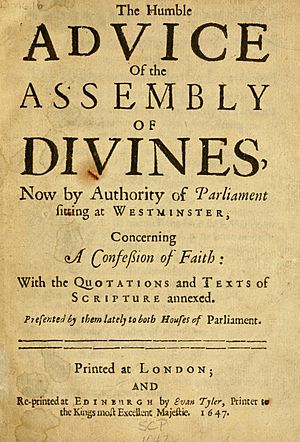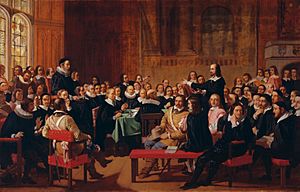Westminster Confession of Faith facts for kids
The Westminster Confession of Faith is an important document that explains the beliefs of some Christian churches, especially those called Presbyterians. It was written a long time ago, in 1646, by a group of wise church leaders in Westminster Abbey in England. This group was called the Westminster Assembly. Their goal was to create a set of beliefs for the Church of England.
Over the years, this Confession became a key guide for the Church of Scotland and many Presbyterian churches around the world. It helps them understand their faith, but it's always seen as less important than the Bible itself. The Assembly also wrote two helpful guides for learning about faith: a Larger Catechism and a Shorter Catechism. Many churches still use these documents today to teach their members.
Some other Christian groups, like the Congregationalists and Particular Baptists, also used the Westminster Confession as a base for their own statements of faith, changing it to fit their specific beliefs. These groups were often called Nonconformists because they didn't follow all the rules of the official Church of England.
Contents
Why Was the Confession Written?
The Westminster Confession was created during a time of big changes in England, known as the English Civil War (1642–1649). During this war, the English Parliament was fighting against King Charles I. The Parliament teamed up with the Covenanters from Scotland.
As part of this alliance, the Scottish Parliament asked the English Parliament to make the Church of England more like their own church, which was Presbyterian. This meant changing how the church was run and what it believed. So, the English Parliament called together 121 religious leaders, mostly Puritans, to meet at Westminster Abbey. Their job was to write official documents to reform the Church of England.
The Confession was finished in 1646. The Church of Scotland quickly accepted it in 1647. In England, the Parliament also adopted parts of it in 1648. However, when the king returned to power in 1660, these changes were canceled. Later, in 1690, when William of Orange became king, the Scottish Parliament again officially accepted the Confession, and it has been important for the Church of Scotland ever since.
What Does the Confession Say?
The Westminster Confession explains many important Christian beliefs, especially those from Calvinism. It talks about ideas that most Christians share, like the Trinity (God as Father, Son, and Holy Spirit) and Jesus' death and resurrection. It also includes ideas specific to Protestantism, such as sola scriptura (the Bible alone is the highest authority) and sola fide (salvation is by faith alone).
About the Bible and God
The Confession starts by explaining that the Bible (both the Old and New Testaments) is the inspired Word of God. It says the Bible is completely true and has God's authority. It contains "all things necessary" for understanding God, getting saved, and living a good life. This means nothing new can be added to the Bible. The Confession teaches that the Bible is the final authority for all religious questions.
It then describes God, explaining the traditional idea of the Trinity. This means there is one God who exists as three persons: God the Father, God the Son (Jesus), and God the Holy Spirit. They are all "of one substance, power, and eternity."
The Confession also talks about predestination. This is the belief that God has, from the beginning of time, decided who will be saved and who will not. It says that God "freely, and unchangeably ordain[ed] whatsoever comes to pass."
Creation, Sin, and God's Plan
The Confession explains that God created human beings in his own image of God, with souls that live forever. Humans were meant to have a close relationship with God. However, it also describes the Fall of Man, when humans sinned. This original sin made all people sinful and guilty before God.
It teaches that God works with humans through different agreements, called covenants. The first was a "covenant of works" with Adam, promising life if he perfectly obeyed. But after the Fall, humans couldn't keep this. So, God made a "covenant of grace" where he freely offers salvation through Jesus Christ. God promises to give those he chooses the Holy Spirit to help them believe.
Jesus Christ and Salvation
The Confession says that Jesus Christ, the second person of the Trinity, was chosen by God to be the mediator between God and humans. It explains that Jesus was born of a virgin and is both fully God and fully human. It teaches that Jesus was crucified, resurrected from the dead, and went up to heaven. He will return to earth to judge everyone.
Jesus' death is described as a sacrifice that makes up for human sins and brings people back into a relationship with God. Salvation is given to people through God's Word and the Holy Spirit, who helps them believe.
The Confession also talks about justification, which means being declared righteous by God. It teaches that people are justified by faith alone, not by their good deeds. This means God sees believers as righteous because of Jesus' perfect life, not because they are perfect themselves. Once justified, a person cannot lose their salvation.
Living a Christian Life
The Confession explains that good works (actions done to obey God) are important for Christians. They don't earn salvation, but they show that someone has true faith and is being changed by the Holy Spirit.
It also discusses Christian liberty, which means Christians are free from human rules that go against God's Word. This freedom helps them serve God. However, it warns that this freedom should not be used to justify sinful behavior.
The Confession describes how Christians should worship God, following the Bible's rules. It also talks about keeping Sunday, the Christian Sabbath, as a special day of rest and worship.
Government and Marriage
The Confession explains the role of civil authorities (governments). It says governments are put in place by God to keep peace and punish wrongdoers. Christians should pray for and obey their leaders. It also states that governments should not interfere with the church's preaching or sacraments.
It covers marriage, saying it should be between a man and a woman. The purposes of marriage are to help each other, have children, and prevent bad behavior. It suggests that Christians should marry other Christians.
The Church and Sacraments
The Confession talks about the Christian Church. It says the church is both invisible (all the people God has chosen to save) and visible (all people on Earth who say they believe in Jesus and their children). Jesus is the head of the church. It teaches that it's usually not possible to be saved outside the visible church.
It also discusses sacraments, which are special actions God established as "signs and seals" of his agreement with people. The Confession says there are only two sacraments: baptism and the Lord's Supper.
- Baptism: This joins a person to the visible church and shows their connection to Jesus. It can be done by sprinkling or pouring water. The Confession supports infant baptism if parents are Christians. It teaches that baptism doesn't automatically save someone, but it's an important sign.
- The Lord's Supper: This is a special meal to remember Jesus' sacrifice. It's not a new sacrifice, but a way to remember the one Jesus made. The Confession rejects the idea that the bread and wine physically change into Jesus' body and blood. Instead, it teaches that believers spiritually receive Jesus by faith when they take part.
Church Leadership and the Future
The Confession explains that church leaders are chosen by Jesus to guide the church. They have the power to discipline members who do wrong, to help them change and keep the church pure.
It also talks about what happens after death. It says that when people die, their bodies go back to dust, but their souls immediately go to God. The souls of good people go to heaven, and the souls of bad people go to a place of torment. It rejects the idea of purgatory.
Finally, the Confession describes the Last Judgment. It says that on the last day, Jesus will return to judge everyone who has ever lived. Good people will receive eternal life with God, and wicked people will face eternal punishment. The exact time of this judgment is unknown.
How the Confession is Used Today
The Westminster Confession is still a very important document for many Presbyterian churches around the world. While some churches have made small changes to it over the years, it remains a key guide for their beliefs and practices.
Churches Using the Confession
- In Australia, the Presbyterian Church of Australia uses it as a guide.
- In England and Wales, the Evangelical Presbyterian Church in England and Wales follows it, with some small differences on certain points.
- In Scotland, the Church of Scotland and the Free Church of Scotland both use it as a main standard.
- In Ireland, the Presbyterian Church in Ireland and the Free Presbyterian Church of Ulster accept it.
- In the United States, many Presbyterian churches, like the Presbyterian Church in the United States of America, adopted the Confession early on. They made some changes over time, especially to remove the idea of the government interfering in church matters.
Images for kids





